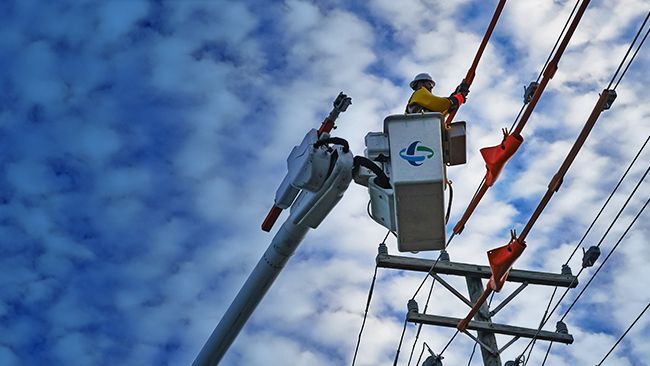Duke Energy Carolinas Receives Approval for New Rates in North Carolina, Implements New Programs To Help Customers
- None.
- None.
Insights
The approval of new rates by the North Carolina Utilities Commission (NCUC) for Duke Energy Carolinas is a significant development in the energy sector. The commitment to invest approximately $7.7 billion in grid upgrades is a substantial capital expenditure that aims to enhance the resilience of the electric grid and reduce the frequency and duration of power outages. This investment is reflective of a broader industry trend where utilities are increasingly prioritizing grid modernization to address aging infrastructure and to prepare for the integration of renewable energy sources.
While this move is expected to improve service reliability, it also implies a higher cost burden for consumers, despite rates remaining below the national average. Investors should monitor the utility's ability to manage these upgrades efficiently and the effectiveness of the performance incentives to ensure that the additional costs translate into tangible improvements in service quality. The balance between infrastructure investment and cost control will be crucial for maintaining customer satisfaction and regulatory support.
The NCUC's approval of the rate increase represents a critical revenue adjustment for Duke Energy Carolinas. With a net increase in retail revenues in the first year, the utility's financial performance is likely to reflect the impact of these changes. The structure of multiyear rates, coupled with performance incentives and penalties, introduces a performance-based rate-making model that aligns the utility's financial incentives with customer service quality and system reliability.
For investors, the key points of interest will be the utility's ability to meet the performance metrics set forth by the NCUC and the subsequent impact on the company's earnings. The performance incentives could potentially serve as a catalyst for operational efficiency and cost management, which could, in turn, bolster investor confidence if successfully implemented.
The ratification of new rates by the NCUC, which includes performance incentives and penalties, indicates a shift towards a more accountable regulatory framework for utilities. This model is designed to ensure that utilities like Duke Energy Carolinas are not only providing services at a reasonable cost but are also incentivized to improve their systems and integrate renewable energy sources.
From a regulatory compliance perspective, the utility will need to navigate the complexities of meeting the established performance metrics. Compliance with these metrics will be critical to avoid penalties and to capitalize on the incentives. This regulatory approach is becoming more common as states seek to encourage utilities to focus on reliability and sustainability without unduly burdening ratepayers.
- Rates include upgrades to make the grid more resilient and shorten the duration of outages
- New programs will give customers more control over energy use and help low-income customers
- Approval includes performance incentives to hold the utility accountable for reliability, encourage renewables and reduce peak system loads
CHARLOTTE, NC / ACCESSWIRE / January 30, 2024 / Duke Energy Carolinas will implement new rates for North Carolina customers on Jan. 15 as approved by the North Carolina Utilities Commission (NCUC).
Rates for North Carolina customers will remain well below the national average, even after Duke Energy Carolinas completes approximately
And as in its Duke Energy Progress order issued in September, NCUC approval covers multiyear rates, along with incentives and penalties to hold the utility accountable for reliability and other performance metrics.
"We've made significant infrastructure upgrades in recent years to meet customer needs and expectations," said Kendal Bowman, Duke Energy's North Carolina president. "This commission order enables us to continue meeting the energy demands of a growing region while limiting annual rate increases and giving customers more cost certainty."
Rate changes start Jan. 15
After extensive evaluation since the rate review was requested last January, along with constructive settlements with the NCUC Public Staff and other parties, the NCUC approved a net increase in retail revenues in year one of about
Customer bills already reflect an interim rate adjustment implemented Sept. 1. Accounting for that, beginning Jan. 15, the change from current rates for a typical residential customer using 1,000 kilowatt-hours (kWh) per month will be an increase of
According to the Edison Electric Institute, the national monthly average for typical residential customers was
The full NCUC rate review order can be found here. Duke Energy Carolinas serves about 2 million households and businesses in central and western North Carolina, including Charlotte, Durham and the Triad.
Help for low-income customers
The NCUC ordered Duke Energy Carolinas to establish a Customer Assistance Program (CAP) that reduces bills for the utility's most vulnerable customers through a
Duke Energy will also refer CAP customers to weatherization and energy efficiency services that can help provide long-term solutions to reduce energy usage. As part of a settlement in the rate cases for both Duke Energy Carolinas and Duke Energy Progress, Duke Energy shareholders will contribute
New options for all customers
For all customers, Duke Energy Carolinas has also established new time-of-use rate options and energy efficiency programs to help lower their costs and reduce energy use:
- Time-of-Use rates incentivize customers to shift electricity use to periods of low energy demand. Simple examples include running a dishwasher overnight or doing laundry on weekends; options are available for commercial and industrial customers as well. More detail can be found at duke-energy.com/NewRatesNC.
- A Tariff on Bill program called "Improve & Save" will enable residential customers - owners and renters - to pay for energy efficiency upgrades through their Duke Energy bill. The program will incentivize customers to replace inefficient electric HVAC systems or insulation in a manner that ensures their annual savings are greater than the monthly cost of the upgrades - improving their service while lowering their bill. The program is expected to launch in first quarter 2024, and a dedicated webpage for the program is coming soon.
"Our goal with these programs is to help offset the rate increase as much as possible by giving customers more control over their energy use," said Bowman. "The programs are designed to reduce costs across the entire system, benefiting all customers."
Holding the utility accountable for reliability, renewables goals
As in the Duke Energy Progress order, another new aspect of this rate approval is the implementation of performance incentive mechanisms (PIMs). First allowed by North Carolina's clean energy legislation (HB951), PIMs advance state policy goals through financial incentives and penalties that encourage utility performance in areas of shared interest with customers.
Following settlements with various participants in the rate review process, the NCUC approved three PIMs with annual incentives that grow up to
- Reliability - holds the utility accountable to maintain expected levels of reliability through graduated penalties that would be distributed to customers if reliability dips below target levels.
- Renewables Integration and Encouragement - encourages adoption of clean energy resources across three categories:
- DER Integration - advances net energy metering (NEM) distributed energy resources (DERs), which allow customers to access zero-emissions generation - such as rooftop solar - at their homes and businesses, reducing their electricity consumption from the grid.
- Large Customer Renewable Program Encouragement - supports large commercial and industrial customers, educational institutions and local governments that have clean energy goals and want access to renewable energy.
- Utility-Scale Interconnection - incentivizes solar and solar-plus-storage interconnections above the estimated annual amounts in Duke Energy's Carbon Plan.
- Time-Differentiated and Dynamic Rate Enrollment - encourages the utility to create and gain approval of innovative rate designs and increase customer participation in existing rates that are designed to reduce system peak load.
A new page on Duke Energy's website allows monitoring of these PIMs as well as other tracking metrics related to customer service, reliability and electric vehicle integration.
Duke Energy Carolinas
Duke Energy Carolinas, a subsidiary of Duke Energy, owns 19,500 megawatts of energy capacity, supplying electricity to 2.8 million residential, commercial and industrial customers across a 24,000-square-mile service area in North Carolina and South Carolina.
Duke Energy (NYSE:DUK), a Fortune 150 company headquartered in Charlotte, N.C., is one of America's largest energy holding companies. Its electric utilities serve 8.2 million customers in North Carolina, South Carolina, Florida, Indiana, Ohio and Kentucky, and collectively own 50,000 megawatts of energy capacity. Its natural gas unit serves 1.6 million customers in North Carolina, South Carolina, Tennessee, Ohio and Kentucky. The company employs 27,600 people.
Duke Energy is executing an aggressive clean energy transition to achieve its goals of net-zero methane emissions from its natural gas business by 2030 and net-zero carbon emissions from electricity generation by 2050. The company has interim carbon emission targets of at least
Duke Energy was named to Fortune's 2023 "World's Most Admired Companies" list and Forbes' "World's Best Employers" list. More information is available at duke-energy.com. The Duke Energy News Center contains news releases, fact sheets, photos and videos. Duke Energy's illumination features stories about people, innovations, community topics and environmental issues. Follow Duke Energy on Twitter, LinkedIn, Instagram and Facebook.
View original content here.

View additional multimedia and more ESG storytelling from Duke Energy on 3blmedia.com.
Contact Info:
Spokesperson: Duke Energy
Website: https://www.3blmedia.com/profiles/duke-energy
Email: info@3blmedia.com
SOURCE: Duke Energy
View the original press release on accesswire.com







